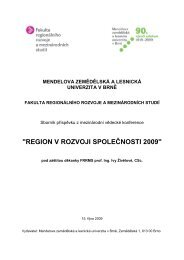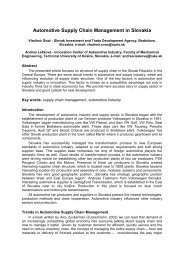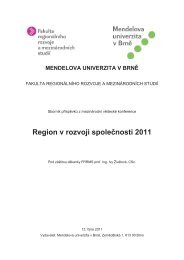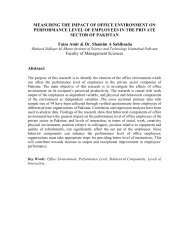performance evaluation in the hospitality industry - Icabr.com
performance evaluation in the hospitality industry - Icabr.com
performance evaluation in the hospitality industry - Icabr.com
Create successful ePaper yourself
Turn your PDF publications into a flip-book with our unique Google optimized e-Paper software.
exhibitions). This takes place typically <strong>in</strong> <strong>the</strong> w<strong>in</strong>ter/shoulder seasons whereas dur<strong>in</strong>g<br />
<strong>the</strong> summer months, when bus<strong>in</strong>ess activity is low, <strong>the</strong>y normally attract Leisure<br />
bus<strong>in</strong>ess.<br />
4. Superior hotels, particularly <strong>in</strong> a European urban environment, are normally small<br />
(boutique or lifestyle) to medium sized. Large hotels are normally to be found <strong>in</strong> <strong>the</strong><br />
Economy (4*) and Budget (3*) star sectors and normally <strong>in</strong> peripheral areas.<br />
5. In recent years, Superior hotels have globally demonstrated a major shift towards<br />
dynamic packag<strong>in</strong>g. This is <strong>the</strong> expectation by <strong>in</strong>dividual travellers to do <strong>the</strong>ir own<br />
book<strong>in</strong>gs via <strong>in</strong>ternet for both airl<strong>in</strong>e/tra<strong>in</strong> seats and hotel beds. Web based<br />
reservation systems are expensive tools that Economy and Budget hotels struggle to<br />
keep up with.<br />
6. In a number of markets, Superior hotels operate with a strong sense of „Coopetition‟,<br />
that is, <strong>com</strong>pet<strong>in</strong>g for bus<strong>in</strong>ess fiercely amongst each o<strong>the</strong>r <strong>in</strong> <strong>com</strong>petition, as is<br />
expected <strong>in</strong> a <strong>com</strong>petitive environment, and yet, resort to cooperation and pull <strong>the</strong><br />
same rope when it <strong>com</strong>es to „lobby<strong>in</strong>g‟ and problem resolution <strong>in</strong> <strong>the</strong> face of a<br />
<strong>com</strong>mon enemy.<br />
10. BLENDING BSC AND AHP: A CONCEPTUAL MODEL<br />
The AHP methodology is particularly useful whenever decision-makers have difficulty <strong>in</strong><br />
determ<strong>in</strong><strong>in</strong>g <strong>the</strong> factor or criteria weights. In <strong>the</strong> BSC subjectivity is limited to <strong>the</strong> choice of<br />
Dimensions/Objectives (KRAs) and avoided outright <strong>the</strong>reafter by <strong>the</strong> equality assumption<br />
hence <strong>the</strong> use of <strong>the</strong> word „Balanced‟. However, <strong>in</strong> <strong>the</strong> AHP, hierarchy and prioritisation are<br />
determ<strong>in</strong>ed through <strong>the</strong> process itself. The only subjective phenomenon is <strong>the</strong> assign<strong>in</strong>g of<br />
<strong>the</strong> pair-wise <strong>com</strong>parisons.<br />
At this juncture, we can use <strong>the</strong> example of prioritiz<strong>in</strong>g between BSC Dimensions and<br />
Objectives as follows <strong>in</strong> Level 3 :<br />
<br />
<br />
<br />
<br />
Dimension 1 (D1) : Customer<br />
Dimension 2 (D2) : Employee<br />
Dimension 3 (D3) : Internal Process<br />
Dimension 4 (D4) : F<strong>in</strong>ance<br />
In Level 4 we follow on by assess<strong>in</strong>g <strong>the</strong> prioritization of Objectives/KRAs accord<strong>in</strong>g to<br />
empirical selection for each Dimension. For <strong>the</strong> purpose of this conceptual model we shall<br />
use only <strong>the</strong> example of Dimension 1 (Customer) accord<strong>in</strong>g to empirical results :<br />
<br />
<br />
<br />
<br />
<br />
<br />
Objective 1 (O1) : Increase <strong>in</strong> Market Share<br />
Objective 2 (O2) : Increase <strong>in</strong> MICE Conversion Rate<br />
Objective 3 (O3) : Increase <strong>in</strong> Repeat Bus<strong>in</strong>ess<br />
Objective 4 (O4) : Increase <strong>in</strong> Guest Satisfaction<br />
Objective 5 (O5) : Improve Customer Profitability<br />
Objective 6 (O6) : Increase Brand Awareness<br />
Level 5 could take us down to <strong>the</strong> level of Tactical Actions for each of <strong>the</strong> Objectives, such<br />
as for Market Share, but this is of little concern on <strong>the</strong> Demand side as <strong>the</strong> customer cares<br />
little as to how <strong>the</strong> Objectives that satisfy his expectations as a hotel guest are achieved.<br />
Also, <strong>the</strong>se are „tactical‟ ra<strong>the</strong>r than „strategic‟ moves :<br />
10









